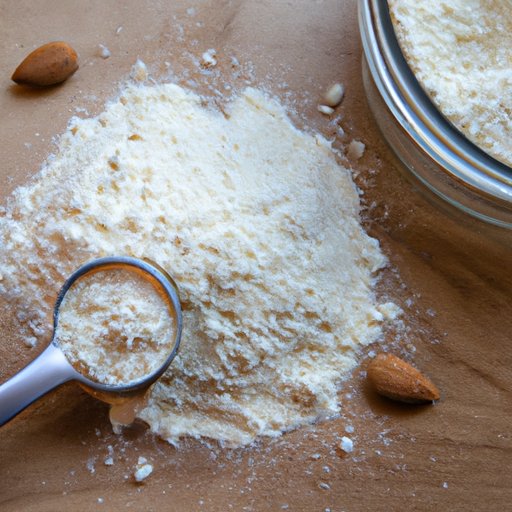
Introduction
Are you tired of struggling to find almond flour at your local grocery store? Look no further as we offer a simple solution to your problem: make your own almond flour at home. Not only is it easy and economical, but it is also healthier and more versatile than store-bought alternatives. In this article, we will cover everything you need to know about making almond flour from scratch.
DIY Almond Flour: a step-by-step guide
Before we begin, it’s essential to gather the necessary materials. All you need is a blender or food processor, raw almonds, and a baking sheet. Here’s a closer look at the process:
1. Soak the Almonds
Begin by soaking raw almonds in water for at least six hours or overnight. This process softens the almonds, making them easier to blend and digest. Once soaked, drain the almonds and rinse them thoroughly.
2. Dry the Almonds
Spread the almonds evenly onto a baking sheet and let them dry for a few hours. You can use a dehydrator or oven set at the lowest temperature to speed up the process. Make sure the almonds are completely dry before moving onto the next step.
3. Grind the Almonds
Place the dried almonds in a blender or food processor and grind them until they reach the desired consistency. For a fine flour, blend for at least two to three minutes. If you prefer a coarser texture, pulse the almonds until they are coarsely ground. Be patient and check the flour’s consistency often to avoid blending it into almond butter.
Additional Tips for Success
- To avoid losing oil content in the almonds, grind them in small batches.
- Store your homemade almond flour in an airtight container in the fridge or freezer to preserve its freshness.
- Experiment with different types of nuts, such as cashews, hazelnuts, or pecans, to create unique flour blends.
Healthier Baking: Homemade Almond Flour
Almond flour is a popular baking ingredient for a reason. Not only is it gluten-free, making it an excellent option for people with gluten sensitivities, but it’s also rich in nutrients. Almonds are high in protein, healthy fats, and fiber, making almond flour a healthier alternative to traditional wheat flour.
Compared to other gluten-free flours on the market, almond flour is dense and holds together better in baked goods. It also adds a nutty and sweet flavor profile to your recipes. Using almond flour in your baking is an easy way to increase the nutrient density of your meals while still satisfying your sweet tooth.
One common concern about almond flour is its high-calorie content. Still, research has shown that eating almonds can help reduce appetite and regulate blood sugar levels, making it a great option for individuals looking to manage their weight or control their blood sugar. In moderation, almond flour is a healthy option for baking and cooking.
From Almonds to Flour: How to Make Your Own Almond Flour
When making homemade almond flour, it’s essential to choose the right type of almonds. The best option is raw, whole almonds with the skin on. Almonds without the skin can still be used, but they will create a finer flour and can be more expensive.
Another important factor to consider when making almond flour is the grind’s coarseness. Different recipes call for different textures of almond flour, meaning you’ll need to adjust the grind accordingly. For example, a cake recipe may require a fine almond flour, while a bread recipe may need a coarser grind.
Almond flour’s versatility also makes it a popular ingredient in gluten-free baking. You can substitute it for traditional wheat flour in most recipes, making it easy to follow your favorite recipes while still enjoying gluten-free options. Almond flour creates moist, flavorful treats that people of all diets can enjoy.
Say Goodbye to Store-Bought Almond Flour with this Simple Recipe
Making your own almond flour is not only healthier, but it’s also more cost-effective. Store-bought almond flour can be quite expensive, but with raw almonds and a blender, it’s a budget-friendly option. Try this simple recipe:
Homemade Almond Flour Recipe
- 1 cup raw almonds
Steps:
- Soak raw almonds in water for at least six hours or overnight.
- Drain and rinse the almonds.
- Dry the almonds on a baking sheet for a few hours or overnight.
- Grind the almonds in a blender or food processor until they reach the desired consistency.
- Store your homemade almond flour in an airtight container in the fridge or freezer.
The Benefits of Making Your own Almond Flour and How to Do It
Homemade almond flour is a healthier, more cost-effective, and versatile alternative to store-bought options. Making your own almond flour also ensures the quality and freshness of the final product. By following our step-by-step guide and additional tips, making almond flour from scratch can be an easy and rewarding process.
If you’re interested in adding almond flour to your recipes, there are plenty of resources available online. With just a little creativity and patience, you can create delicious, healthy meals that everyone can enjoy.
Conclusion
In summary, making your own almond flour at home is a simple, cost-effective, and healthier alternative to store-bought options. By soaking, drying, and grinding raw almonds, you can quickly create a flour that is rich in nutrients and flavors. Additionally, almond flour is a versatile ingredient that can replace traditional wheat flour in most recipes, making it a popular choice for gluten-free diets. We hope this guide has been helpful, and we encourage you to try making almond flour yourself and enjoy the benefits of healthier baking.




